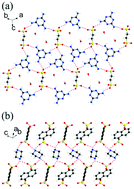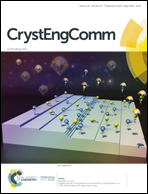Supramolecular hydrogen-bonded organic networks through acid–base pairs as efficient proton-conducting electrolytes†
Abstract
The research of developing new proton-conducting materials via a simple and cost-effective method is vital in fuel cell technology. In this study, two new supramolecular hydrogen-bonded organic networks (SHONs) have been synthesized via a traditional aqueous solution synthesis or an environmentally friendly grinding synthesis method by using sulfonate and N-donor ligands without a solvent. Discrepancies in particle size and micro-morphology were presented in these SHONs synthesized via different synthetic methods, resulting in obvious distinction of proton conductivity in the corresponding compound. Contact angle measurements and field-emission scanning electron microscopy were also used to explain the intrinsic and extrinsic discrepancies in proton conductivity of each compound synthesized by different methods. Density functional theory calculations proved that the polar charge interactions spurred the formation of hydrogen-bonded networks and compound 2 should have a little higher proton conductivity. The formed SHONs exhibited a high proton conductivity value of up to 10−2 S cm−1 under 97% RH, which can potentially be used in proton-exchange membrane fuel cells.



 Please wait while we load your content...
Please wait while we load your content...